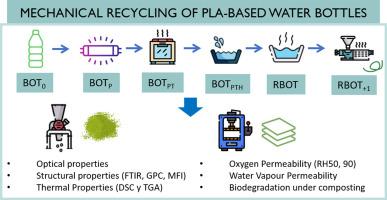Simulated secondary mechanical recycling of PLA water bottles: insights into structural integrity, barrier performance, and biodegradability
IF 10.9
1区 环境科学与生态学
Q1 ENGINEERING, ENVIRONMENTAL
引用次数: 0
Abstract
The presence of compostable packaging in the market has increased driven by growing environmental concerns regarding plastic pollution. However, certain biopolymers, such as poly (lactic acid) (PLA) represent high-value materials whose compostability may lead to a loss of valuable resources. In this study, the impact of the mechanical recycling of commercial PLA-based plastic water bottles and subsequent reprocessing on their structural and technological properties was investigated for the first time with the objective of evaluating its recyclability and potential further use. The mechanical recycling simulation included photochemical, thermal, hydrothermal, and washing processes, followed by extrusion reprocessing. Structural analyses revealed the occurrence of chemical modifications, such as chain scission and increased melt fluidity, that resulted on significantly higher oxygen and water vapor permeabilities than those of the original bottle. Thermal analyses indicated increase in crystallinity values of post-consumer and reprocessed bottles, that led to a slowing down of the biodegradation process.

模拟二次机械回收PLA水瓶:洞察结构完整性,屏障性能,和生物降解性
由于对塑料污染日益增长的环境担忧,市场上可堆肥包装的存在有所增加。然而,某些生物聚合物,如聚乳酸(PLA)代表高价值材料,其可堆肥性可能导致宝贵资源的损失。在这项研究中,首次研究了商用pla基塑料水瓶的机械回收和随后的再加工对其结构和技术性能的影响,目的是评估其可回收性和进一步利用的潜力。机械回收模拟包括光化学、热、水热和洗涤过程,然后是挤压再处理。结构分析显示,发生了化学修饰,如链断裂和熔体流动性增加,导致氧气和水蒸气渗透率明显高于原始瓶子。热分析表明,消费后和再加工的瓶子结晶度值增加,导致生物降解过程减慢。
本文章由计算机程序翻译,如有差异,请以英文原文为准。
求助全文
约1分钟内获得全文
求助全文
来源期刊

Resources Conservation and Recycling
环境科学-工程:环境
CiteScore
22.90
自引率
6.10%
发文量
625
审稿时长
23 days
期刊介绍:
The journal Resources, Conservation & Recycling welcomes contributions from research, which consider sustainable management and conservation of resources. The journal prioritizes understanding the transformation processes crucial for transitioning toward more sustainable production and consumption systems. It highlights technological, economic, institutional, and policy aspects related to specific resource management practices such as conservation, recycling, and resource substitution, as well as broader strategies like improving resource productivity and restructuring production and consumption patterns.
Contributions may address regional, national, or international scales and can range from individual resources or technologies to entire sectors or systems. Authors are encouraged to explore scientific and methodological issues alongside practical, environmental, and economic implications. However, manuscripts focusing solely on laboratory experiments without discussing their broader implications will not be considered for publication in the journal.
 求助内容:
求助内容: 应助结果提醒方式:
应助结果提醒方式:


